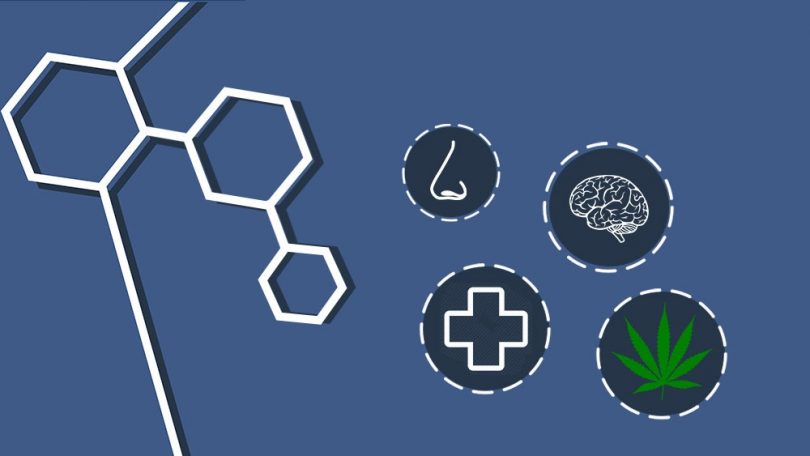A common occurrence, or a rare event?
Many people don’t realize it, but terpenes have been industrially used for a long time in the form of turpentine! And like with any industrial solvent, it’s possible to accidentally swallow or inhale enough of it that it becomes a cause for concern. So, the question becomes, do the terpenes we consider an essential part of our cannabis culture pose a risk of toxicity?
High concentration sprays or mists of terpenes have long been used as natural insecticides for protection of crops and homes from pesky pests. [1] Linalool and geraniol are especially implicated as compounds demonstrating high toxicities [2], and their use, in combination to increase efficacy against specific critters, is of large interest in the field of green chemistry. [3] Terpenes also exhibit auto-toxicity—meaning they are actually dangerous to the plant that produces them! That’s why terpenes are contained in specially-designed structures like oil tubes or glands (Cannabis species use trichomes for this purpose).
While terpenes are highly microbicidal, cannabis-derived terpenesconsidered safe for human use and consumption within the concentrations in which they are normally present, particularly in their topical use as modifiers of skin tissue permeability. [4] Many terpenes are present on the FDA’s list of “Generally Recognized As Safe” (GRAS) materials.
It becomes trickier to assess how safe terpenes are when they are used in more modern methods of cannabis consumption. Dabbing is one of those more difficult methods to assess, because large amounts of terpenes can be inhaled at a time, and very little data currently exists in the scientific or medical literature regarding repeated exposures to dabs. [5] Likewise, in the preparation of vape oil, it’s often standard procedure to first extract and distill the THC from the starting cannabis material, and then add a flavor master mixture back to the oil to make the final preparation.
Patients with terpene toxicities may first exhibit nausea and/or vomiting. In severe cases, single and self-limited seizures have been reported. [6-7] According to Medscape, the severity of toxic exposure to terpenes is largely related to the degree of CNS depression which can manifest as symptoms of dizziness, confusion, narcolepsy, and losing consciousness or slipping into a coma.
As with any worries regarding the ingestion or exposure to compounds, you can always consult the national Poison Control hotline at 888-222-1222. They also have a large online database of information where you can search for help regarding a specific ailment using the same guidelines available to the operators you call.
References
- Scalerandi, Esteban, et al. “Understanding Synergistic Toxicity of Terpenes as Insecticides: Contribution of Metabolic Detoxification in Musca domestica”. Front Plant Sci. 2018; 9: 1579 [Times cited = 2, Journal impact factor = 4.298].
- Phillips, Thomas P. et al. “Toxicity of Terpenes Secreted by the Predator Xylocovis flauipes (Reuter) to Tribolium castaneum (Herbst) and OvyzaephiIus surinamensis (L.)”. Stored Prod. Res. 1995; 31(2): 131-8 [Times cited = 22, Journal impact factor = 0.832].
- Moraes, M.M. et al. “Comparative toxicity of essential oil and blends of selected terpenes of Ocotea species from Pernambuco, Brazil, against Tetranychus urticae Koch”. An Acad Bras Cienc. 2017 Jul-Sep;89(3):1417-1429 [Times cited = 4, Journal impact factor = 0.418].
- Mendanha, Sebastiao A. et al. “Toxicity of terpenes on fibroblast cells compared to their hemolytic potential and increase in erythrocyte membrane fluidity”. in Vitro. 2013; 27(1): 323-9 [Times cited = 39, Journal impact factor = 2.903].
- Meehan-Atrash, J. et al. “Toxicant Formation in Dabbing: The Terpene Story”. ACS Omega. 2017; 2(9): 6112-7 [Times cited = 9, Journal impact factor = N/A].
- Khine, H., et al. A cluster of children with seizures caused by camphor poisoning. Pediatrics. 2009; 123(5): 1269-72 [Times cited = 58, Journal impact factor = 5.705].
- Rahimi, M., et al. Severe camphor poisoning, a seven-year observational study. Environ Toxicol Pharmacol. 2017; 52: 8-13 [Times cited = 1, Journal impact factor = 2.084].
Image Citation: Greencamp








